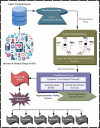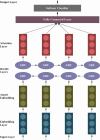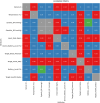An ensemble of deep representation learning with metaheuristic optimisation algorithm for critical health monitoring using internet of medical things
- PMID: 40784985
- PMCID: PMC12336321
- DOI: 10.1038/s41598-025-15005-9
An ensemble of deep representation learning with metaheuristic optimisation algorithm for critical health monitoring using internet of medical things
Abstract
The Internet of Things (IoT) plays a significant part in the healthcare field. The growth of smart devices, smart sensors, and advanced lightweight communication protocols has created an opportunity to connect medical devices for monitoring biomedical signals and identifying patients' illnesses without human involvement, known as the Internet of Medical Things (IoMT). The IoMT enables a medical method to connect various smart devices, such as hospital assets, wearable sensors, and medical examination instruments, to create an information platform. In recent times, the IoMT has been extensively utilized in various areas, including disease diagnosis, smart hospitals, infectious disease tracking, and remote health monitoring. Still, safety is one of the key requirements for the success of IoMT systems. Thus, at present, deep learning (DL) is considered a safe IoMT system, as it can enhance the system's performance. In this manuscript, the Ensemble of Deep Learning and Metaheuristic Optimisation algorithms for the Critical Health Monitoring (EDLMOA-CHM) technique is proposed. The EDLMOA-CHM technique aims to develop and evaluate effective methods for monitoring health conditions in the IoMT to enhance healthcare system security and patient safety. Initially, the Z-score normalization method is employed in the data pre-processing step to clean, transform, and organize raw data into an appropriate format. For the feature selection process, the binary grey wolf optimization (BGWO) model is employed to identify and retain the most significant features in the dataset. The classification process utilizes ensemble models, including the Temporal Convolutional Network (TCN), the Attention-based Bidirectional Gated Recurrent Unit (A-BiGRU), and the Hybrid Deep Belief Network (HDBN) techniques. To further optimize model performance, the pelican optimization algorithm (POA) is utilized for hyperparameter tuning to ensure that the optimum hyperparameters are chosen for enhanced accuracy. To demonstrate the improved performance of the EDLMOA-CHM model, a comprehensive experimental analysis is conducted using the healthcare IoT dataset. The comparison analysis of the EDLMOA-CHM model demonstrated a superior accuracy value of 99.56% over existing techniques.
Keywords: Critical health monitoring; Ensemble deep learning; Feature selection; Internet of medical things; Metaheuristic optimisation algorithm.
© 2025. The Author(s).
Conflict of interest statement
Competing interests: The authors declare no competing interests. Ethics approval: This article does not contain any studies with human participants performed by any of the authors.
Figures














Similar articles
-
A deep dive into artificial intelligence with enhanced optimization-based security breach detection in internet of health things enabled smart city environment.Sci Rep. 2025 Jul 2;15(1):22909. doi: 10.1038/s41598-025-05850-z. Sci Rep. 2025. PMID: 40594312 Free PMC article.
-
Integration of metaheuristic based feature selection with ensemble representation learning models for privacy aware cyberattack detection in IoT environments.Sci Rep. 2025 Jul 2;15(1):22887. doi: 10.1038/s41598-025-05545-5. Sci Rep. 2025. PMID: 40595948 Free PMC article.
-
An ECG signal processing and cardiac disease prediction approach for IoT-based health monitoring system using optimized epistemic neural network.Electromagn Biol Med. 2025;44(3):325-347. doi: 10.1080/15368378.2025.2503334. Epub 2025 May 10. Electromagn Biol Med. 2025. PMID: 40347178
-
An Ensemble Model Health Care Monitoring System.Crit Rev Biomed Eng. 2024;52(6):33-54. doi: 10.1615/CritRevBiomedEng.2024049488. Crit Rev Biomed Eng. 2024. PMID: 39093446 Review.
-
Intelligent wearable-assisted digital healthcare industry 5.0.Artif Intell Med. 2024 Nov;157:103000. doi: 10.1016/j.artmed.2024.103000. Epub 2024 Oct 22. Artif Intell Med. 2024. PMID: 39481247 Review.
References
-
- Zhang, T. et al. A joint deep learning and internet of medical Things-driven framework for elderly patients. IEEE Access.8, 75822–75832 (2020).
-
- Raj, R. J. S. et al. Optimal feature selection-based medical image classification using a deep learning model in the Internet of Medical Things. IEEE Access8, 58006–58017 (2020).
-
- Ding, Y. et al. DeepEDN: a deep-learning-based image encryption and decryption network for internet of medical things. IEEE Internet Things J.8 (3), 1504–1518 (2020).
-
- Mohsin, M. K., Almasoodi, A. Y. J. & Qassim, M. Differential equation of COVID-19 with constraint algebraic equation and sustainable health development with applications in neutrosophic environment. Int. J. Neutrosophic Sci. (IJNS)26, 2 (2025).
-
- Ahmad, S. et al. Deep learning enabled disease diagnosis for secure internet of medical things. Comput. Mater. Continua73, 1 (2022).
MeSH terms
LinkOut - more resources
Full Text Sources

